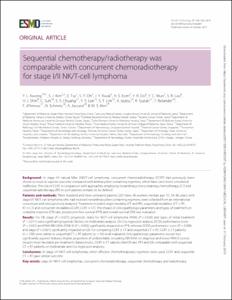KUMEL Repository
1. Journal Papers (연구논문)
1. School of Medicine (의과대학)
Dept. of Internal Medicine (내과학)
Sequential chemotherapy/radiotherapy was comparable with concurrent chemoradiotherapy for stage I/II NK/T-cell lymphoma
- Keimyung Author(s)
- Do, Young Rok
- Department
- Dept. of Internal Medicine (내과학)
- Journal Title
- Annals of Oncology
- Issued Date
- 2018
- Volume
- 29
- Issue
- 1
- Keyword
- concurrent chemoradiotherapy; sequential chemotherapy and radiotherapy; stage I/II NK/T-cell lymphomas
- Abstract
- Background:
In stage I/II natural killer (NK)/T-cell lymphoma, concurrent chemoradiotherapy (CCRT) had previously been shown to result in superior outcome compared with anthracycline-containing regimens, which have since been considered ineffective. The role of CCRT in comparison with approaches employing nonanthracycline-containing chemotherapy (CT) and sequential radiotherapy (RT) in such patients remains to be defined.
Patients and methods:
Three hundred and three untreated patients (207 men, 96 women; median age: 51, 18-86 years) with stage I/II NK/T-cell lymphoma who had received nonanthracycline-containing regimens were collected from an international consortium and retrospectively analyzed. Treatment included single modality (CT and RT), sequential modalities (CT + RT; RT + CT) and concurrent modalities (CCRT; CCRT + CT). The impact of clinicopathologic parameters and types of treatment on complete response (CR) rate, progression-free-survival (PFS) and overall-survival (OS) was evaluated.
Results:
For CR, stage (P = 0.027), prognostic index for NK/T-cell lymphoma (PINK) (P = 0.026) and types of initial treatment (P = 0.011) were significant prognostic factors on multivariate analysis. On Cox regression analysis, ECOG performance score (P = 0.021) and PINK-EBV DNA (PINK-E) (P = 0.002) significantly impacted on PFS; whereas ECOG performance score (P = 0.008) and stage (P < 0.001) significantly impacted on OS. For comparing CCRT ± CT and sequential CT + RT, CCRT ± CT patients (n = 190) were similar to sequential CT + RT patients (n = 54) in all evaluated clinicopathologic parameters except two significantly superior features (higher proportion of undetectable circulating EBV DNA on diagnosis and lower PINK-E scores). Despite more favorable pre-treatment characteristics, CCRT ± CT patients had CR rate, PFS and OS comparable with sequential CT + RT patients on multivariate and Cox regression analyses.
Conclusions:
In stage I/II NK/T-cell lymphomas, when effective chemotherapeutic regimens were used, CCRT and sequential CT + RT gave similar outcome.
- Keimyung Author(s)(Kor)
- 도영록
- Publisher
- School of Medicine (의과대학)
- Citation
- Y. L. Kwong et al. (2018). Sequential chemotherapy/radiotherapy was comparable with concurrent chemoradiotherapy for stage I/II NK/T-cell lymphoma. Annals of Oncology, 29(1), 256–263. doi: 10.1093/annonc/mdx684
- Type
- Article
- ISSN
- 0923-7534
- Appears in Collections:
- 1. School of Medicine (의과대학) > Dept. of Internal Medicine (내과학)
- 파일 목록
-
-
Download
 oak-2018-1005.pdf
기타 데이터 / 418.87 kB / Adobe PDF
oak-2018-1005.pdf
기타 데이터 / 418.87 kB / Adobe PDF
-
Items in Repository are protected by copyright, with all rights reserved, unless otherwise indicated.